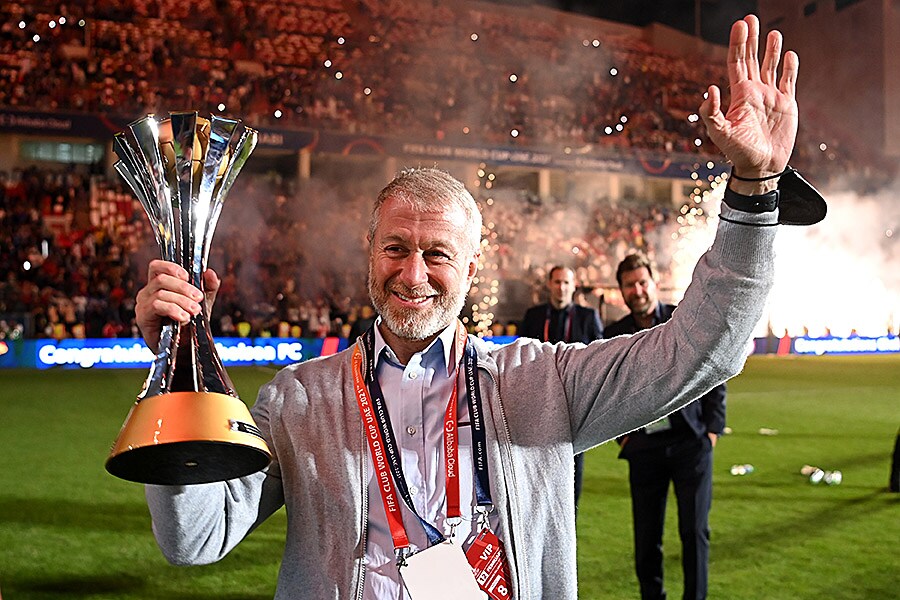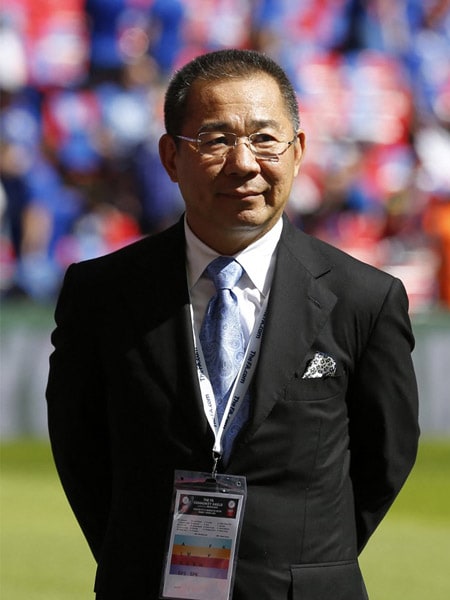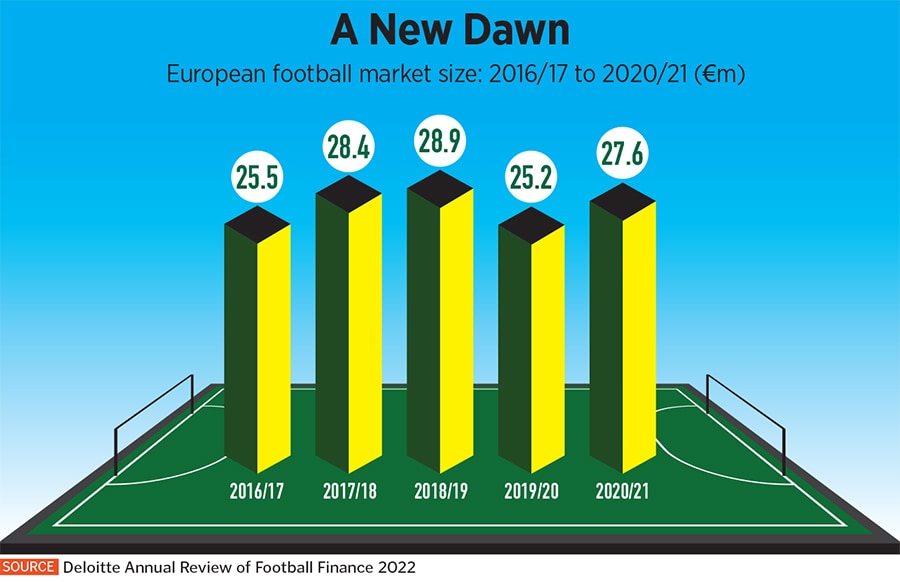Manchester United, which has won the league 13 times, has been working the headlines double-shift: First, with an explosive interview by its Portuguese superstar Cristiano Ronaldo, railing against the owners and manager Erik ten Hag. Ronaldo has subsequently exited through a “mutual agreement", but the Glazers family, which bought the club in 2005, continues to remain in the news for putting Manchester United up for sale.
But the Red Devils aren’t the only ones looking for buyers. Early in November, the US-based Fenway Sports Group (FSG), which owns six-time Champions League winners Liverpool since 2010, announced that it was ready to trade hands. Media reports surfaced soon after, claiming Mukesh Ambani, chairman and managing director of Reliance Industries (which owns the Network18 Group that publishes Forbes India), has entered the race for the bid.
While there has been no word yet, it turns the spotlight on Indian billionaires, who are growing in might both on and off the field. As the Forbes’ billionaires’ list published in April stipulates, the total number of Indian billionaires rose from 140 last year to 166 in 2022, while their combined wealth grew by 26 percent to $750 billion.
A few of these billionaires, Ambani included, own cricket franchises in India and abroad, while many hold a stake in the homegrown Indian Super League (ISL) that is co-promoted by Reliance. Should Indian billionaires now turn their sights to top-flight football clubs? If you consider the timing, it"s a go.
![]()
Many European clubs are owned by Russian oligarchs and Chinese billionaires, both of whom are now on the wane due to geopolitics: The former due to sanctions following the Ukraine invasion (that led Roman Abramovich to sell Chelsea in March), and the latter due to the state’s clampdown on investments in professional football clubs. According to a report in Deutsche Welle, the number of major Chinese investors in European clubs has halved from 20 in 2017 to 10 in 2021. “This creates a partial vacuum amid the clutch of American and Middle Eastern owners, and Indian billionaires would be in a good position to go into that space," says Kieran Maguire, a teacher at the University of Liverpool Management School and author of The Price of Football.
Along with owning a football club comes bragging rights, and an identity that goes beyond business ventures, personal jets, super yachts or, say, a penthouse in Manhattan. “If Roman Abramovich were to walk the streets of London prior to 2002-03, when he bought Chelsea, no one would recognise him," says Joe Morrison, renowned football presenter and pundit, of the billionaire who part-owns multinational steelmaker Evraz. “Now everyone knows what he looks like, and he was being used as a go-between in the early days of the Ukraine war. Prior to Chelsea, Abramovich would never have been involved in that kind of a conversation."
While such an influence is good for the ego, it can be equally uplifting for one’s business ventures, with the eyeballs it brings not only in the home market, but from around the world. Take PL for instance: The English league is now broadcast to 800 million homes in 188 countries and has 90 broadcasters and more than 400 channels beaming the games. A news report in Reuters states that for the first time in its 30-year history, the league will earn more from foreign TV deals than domestic ones, expecting its foreign rights sales to generate £5.3 billion over the next three seasons against £5.1 billion raised from UK broadcasters.
Picture how King Power, Thailand’s leading operator of airport duty-free stores, has found global recall and resonance through its tie-ups with Leicester City, a club owned by the Srivaddhanaprabha family that also founded the travel retail company. Under a sponsorship deal, Leicester City’s home ground, once called the Walkers Stadium, was rechristened King Power Stadium in 2011.
More recently, Newcastle United has been taken over by a Saudi consortium led by the Public Investment Fund that invests on behalf of the government. The club has already partnered with Saudia as its official tour airline partner, ahead of their December tour to Riyadh for a match against Al-Hilal. Says Morrison: “If an Indian billionaire takes over a PL or any other European club, their products will be splashed across the globe. Such branding gives you a platform to the world."
![]() Russian oligarch Roman Abramovich had to sell his club Chelsea for £2.5 billion after sanctions were imposed by the UK government following the Ukraine invasionImage: Michael Regan - FIFA/FIFA via Getty Images
Russian oligarch Roman Abramovich had to sell his club Chelsea for £2.5 billion after sanctions were imposed by the UK government following the Ukraine invasionImage: Michael Regan - FIFA/FIFA via Getty Images
Bang for the buck?
With the whopping valuations floating around for both Liverpool and Manchester United, ranging anywhere between £4-7 billion, does buying a football club bring bang for the buck? “If you are asking about an annual return on investment, it’s questionable," says Maguire. “But in terms of capital value growth, FSG, the owners of Liverpool, could be walking away with a 12x multiple given that they bought the club for £300 million and could be getting £3.5-4 billion from the sale."
The Glazers, who bought Manchester United for £790 million, could be looking at a 5x return or an even greater multiple considering that only £270 million of their investment came from their own pockets, and the rest from banks. “You only have to repeat that to a degree to a new investor to get a return on their investment," adds Maguire. Even Chelsea’s distress sale post the Ukraine war fetched Abramovic £2.5 billion against the £140 million he bought it for and, had the money not all gone into the UK government account to be later channelled towards relief work in Ukraine, Abramovic would have walked away with a profit despite The Blues ending FY21 with post-tax losses of £145.6 million.
“For every club owner, the objective of having a franchise is quite different. If an owner is looking to leverage the fan base for pushing out their businesses, they might look at some of the losses as a marketing expense," says Akshay Tandon, co-owner of FC Goa, an ISL club. “If history is any indication, no foreign buyer has gone to Europe to develop football—it has been a business or a strategic move, or a passion project."
Besides, most Indian sports franchises don’t own tangible assets in terms of stadiums, training grounds etc, which most elite European football clubs own. “When you are buying at these valuations, these are assets that will appreciate as well," says Pradhyum Reddy, CEO of Dempo FC and an expert on Sports18’s Fifa coverage panel. “The valuation of an IPL team might be of astronomical proportions, but they don’t physically own anything."
Also read: Loitongbam Ashalata Devi: Inspiring the new generation of Indian footballers
It’s a win-win for the clubs as well, seamlessly foraying into the burgeoning consumption market that is Asia. BBC reports that when Manchester United registered a commercial revenue loss of £46.8 million in 2021, the club attributed it “primarily to Covid disruptions", which included the cancellation of the first team’s pre-season tour to India.
This July, Liverpool played Manchester United in a pre-season game in Thailand, and Crystal Palace in Singapore. “It"s not my favourite thing to do," manager Jurgen Klopp told the BBC in an interview. “If we could do two weeks in Austria and train twice a day there, that would be better. But we know how big our fan base is in Asia and to be close to them is a wonderful thing."
Adds Maguire: “Both Manchester City and Newcastle have signed lucrative commercial and sponsorship deals with organisations in the Middle East. Manchester City now has over £300 million a year coming from sponsorship deals, which is 48 percent of its total revenue." According to media reports, the club owned by the City Football Group (CFG), in which UAE Deputy Prime Minister Mansour bin Zayed bin Sultan Al Nahyan is a majority shareholder, earns upwards of £67.5 million per year as sponsorship from Etihad, the flagship carrier of Abu Dhabi.
![]() Vichai Srivaddhanaprabha image credits: Ian Kington / AFP
Vichai Srivaddhanaprabha image credits: Ian Kington / AFP
Head vs heart
While buying a club is only the first, and perhaps the easier, step, the bigger challenge lies in a seamless transition and a smooth run thereafter. “In England, and other European clubs, owners aren’t the stars even if you spend billions to buy the club. As an owner you need to stay in the background," says Mark Seagraves, a former Liverpool and Manchester City player who now runs The Football Faktory in India to train kids.
That involves the necessary due diligence and also building up a relationship with the local community that usually serves as the club’s fan base for generations. “In India, I"ve seen Mumbai Indian fans watching IPL matches chanting for MS Dhoni," says Tandon of FC Goa. "That would not happen in Europe, where fandom is generational and part of the club"s DNA."
The Glazers family, which also owns NFL team Tampa Bay Buccaneers in the US, has shared a fractious relationship with Manchester United fans ever since their acquisition, over borrowings that thumped a £500 million debt on the club. Since 2005, through PL and Champions League victories and high-profile hirings like Ronaldo, the fans have continued to protest against the owners and sponsors, evident through the ‘Love United Hate Glazers’ stickers that can often be spotted on properties around the stadium. Last April, they stormed the pitch at Old Trafford, their home ground, and forced the postponement of a league game against Liverpool.
![]()
Similar horror stories were abound with a homegrown owner—the Pune-based Venkateshwara Hatcheries Group, popularly known as Venky’s—that acquired 1995 PL champions Blackburn Roversin 2010, promised to get Ronaldinho and Diego Maradona to play for the team, and then led the club into relegation, sacking managers at will and effecting a swirling financial mess. In December, fans released chickens onto the pitch to protest against the owners, and, in 2011, they were booed out of the stadium during a match.
At the other end of the spectrum would be the Thai owners of Leicester City under whose stewardship the club won its only PL title in 2015-16. Through a modestly assembled squad—a report in Guardian pegs their wages bill to $100 million, about a quarter of the Manchester United side that year—and an approach that saw “doughty defence and a clever attack", they wrote what could probably be counted as one of the biggest underdog stories in world sports. The team also won the FA Cup in the 2020-21 season, another first in their 137-year-history.
While the players notch up results on the field, the owners have done everything to provide stability to the club off it, earning an adulation from fans that’s almost unseen in the sport around the world. There was an outpouring of grief among Leicester fans when Vichai Srivaddhanaprabha, who bought the club in 2010 for a princely £39 million, died in a helicopter crash outside the King Power stadium in 2018. After his demise, son Aiyawatt has continued with his tradition of looking after the club (valued at £742 million as of May 2022, according to Forbes) and its supporters.
![]()
During his lifetime, Vichai had given out free donuts and beer to supporters at the stadium, subsidised buses for away games and increased ticket prices only marginally, while the son, among other things, is said to have paid for 75 hotel rooms for a group of fans who got stuck in a storm in Calais after travelling to support Leicester’s Belgian sister club OH Leuven. A report in LeicestershireLive quotes a survey of 3,000 English football fans that voted Aiyawatt, better known as ‘Top’, as the best PL club owner. Bottomline: You buy a football club, you also buy into the community.
But it’s a tricky line to straddle both emotion and business canny. Due diligence is key, says Morrison, citing the cases of Liverpool and Manchester United. “Both the clubs are going for a ballpark figure of £5-7 billion. ManU requires huge investment over and above because parts of the stadium are dilapidated, training facilities need a facelift. FSG, on the other hand, revamped Anfield during their tenure," he says. “Basic due diligence will tell you that even if the sales values are similar for the two clubs, one is going to require a lot more for the same level of facilities."
Budgeting for such expenses shouldn’t be overlooked as, while they might be a drain on resources in the short term, they will eventually contribute to their coffers through gate receipts. “There is a good business case saying demolish Old Trafford, and start again in exactly the same way we’ve seen Tottenham Hotspurs do their match-day revenues have tripled on the back of a stadium revamp," says Maguire.
![]()
The Tom Hicks and George Gillett fiasco is proof of how financial mismanagement can take a toll on a club’s performance. The duo took a £220-million loan from the Royal Bank of Scotland to purchase Liverpool in 2007 and transferred the debt to the club’s parent company. By the time they were forced to sell the club to FSG, following a court battle in 2010, the debt ballooned to £237 million, stripping The Reds of their transfer budget. While Liverpool managed to finish as runners-up to Manchester United in the PL in 2008-09, they couldn’t go any higher than sixth for the next five years, till the 2013-14 season, when they returned to the second position.
Also read: LGBT football fans fight for safe space in Brazil stadiums
The India Connection
If an Indian billionaire were to acquire a European football club, would it open up a two-way street, affording more kids an opportunity to train at their academies and make it to the first team? It’s not a given, feels Reddy of Dempo FC. “Inter Milan has had Chinese owners since 2016. But we haven’t seen a stream of Chinese players coming into the Serie A," says Reddy. “Similarly, a move from India to PL is unlikely to happen. These clubs are highly meritocratic. What’s more realistic is a movement in the other direction—of clubs coming over to play pre-season or friendlies, players coming down for visits, coaches offering their knowhow."
![]() But Seagraves disagrees. He believes it will give Indian football the right kind of exposure to take off. When he came to India 10 years ago to train kids and help them play in foreign clubs, he realised there was no real infrastructure and professionalism for that. “If an Indian guy could go to Europe and bring those coaches over, even on a small scale, it might set the ball rolling for bigger things," he says.
But Seagraves disagrees. He believes it will give Indian football the right kind of exposure to take off. When he came to India 10 years ago to train kids and help them play in foreign clubs, he realised there was no real infrastructure and professionalism for that. “If an Indian guy could go to Europe and bring those coaches over, even on a small scale, it might set the ball rolling for bigger things," he says.
It would also import the playbook of some sound business practices that have stood the European clubs in good stead. The transfer market, for instance, in which players relocate from one club to another before the expiry of their contracts, forms a big revenue stream for elite clubs. When Brazilian superstar Neymar moved from FC Barcelona to his current club Paris Saint-Germain, the latter pocketed a neat €222 million.
In India, transfers are only a few seasons old (with auctions being predominant before that) and are only gradually catching up. In the 2019-20 season, ISL clubs are said to have spent Rs 1.4 crore on transfers, and while the numbers jumped to Rs 9.5 crore in the following season, there’s still a long way to go. “An Indian owner of a foreign club can directly influence sharing of expertise with the European club. This creates a bridge for knowledge back to sport in India," says Morrison.
“Ten years ago, when I was living in Delhi, it was all cricket everywhere," adds Seagraves. “Now it’s not. You see a lot more people wearing football jerseys, a number of supporter clubs have sprouted. We need a player that can represent India in the European leagues, we need practices that can push the momentum. Only then can we have an Indian team playing in the World Cup."







 But Seagraves disagrees. He believes it will give Indian football the right kind of exposure to take off. When he came to India 10 years ago to train kids and help them play in foreign clubs, he realised there was no real infrastructure and professionalism for that. “If an Indian guy could go to Europe and bring those coaches over, even on a small scale, it might set the ball rolling for bigger things," he says.
But Seagraves disagrees. He believes it will give Indian football the right kind of exposure to take off. When he came to India 10 years ago to train kids and help them play in foreign clubs, he realised there was no real infrastructure and professionalism for that. “If an Indian guy could go to Europe and bring those coaches over, even on a small scale, it might set the ball rolling for bigger things," he says.